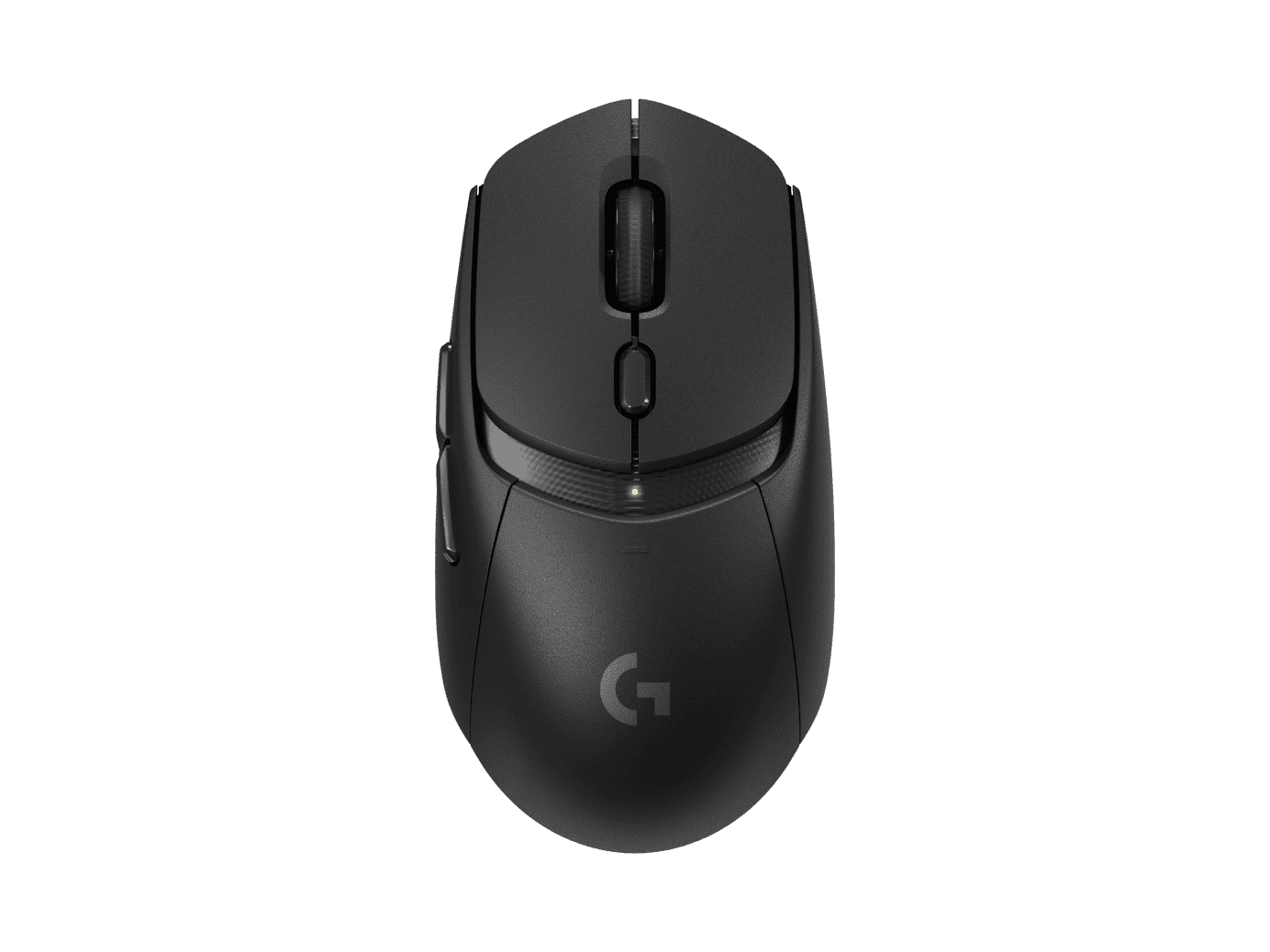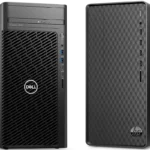Gaming mice have come a long way in recent years, with lightweight options becoming more popular. A light mouse can help you move faster and play longer without hand fatigue. Many gamers now look for mice weighing under 70 grams to improve their gameplay and comfort.
The lightest gaming mice offer quick movements while maintaining accuracy and control. These mice use special materials like honeycomb shells or lightweight plastics to cut weight. Some brands have created mice weighing as little as 50 grams or less without sacrificing features.
When shopping for a lightweight mouse, pay attention to the sensor quality, button durability, and shape for your grip style. Weight distribution matters just as much as the total weight—a well-balanced mouse feels better than an unevenly weighted one. Cable flexibility (or wireless capability) is also important since a stiff cable can create drag that makes even the lightest mouse feel heavy. We tested dozens of lightweight mice across different games and tasks to find the ones that offer the best balance of weight, performance, and comfort.
Best Lightest Mouse
We’ve tested dozens of lightweight mice to find the ones that won’t weigh down your gaming or work sessions. Our top picks combine feather-light designs with solid performance and comfort for long hours of use. These ultralight options help reduce hand fatigue while still giving you the precision and speed you need.
Logitech G Pro Wireless Mouse
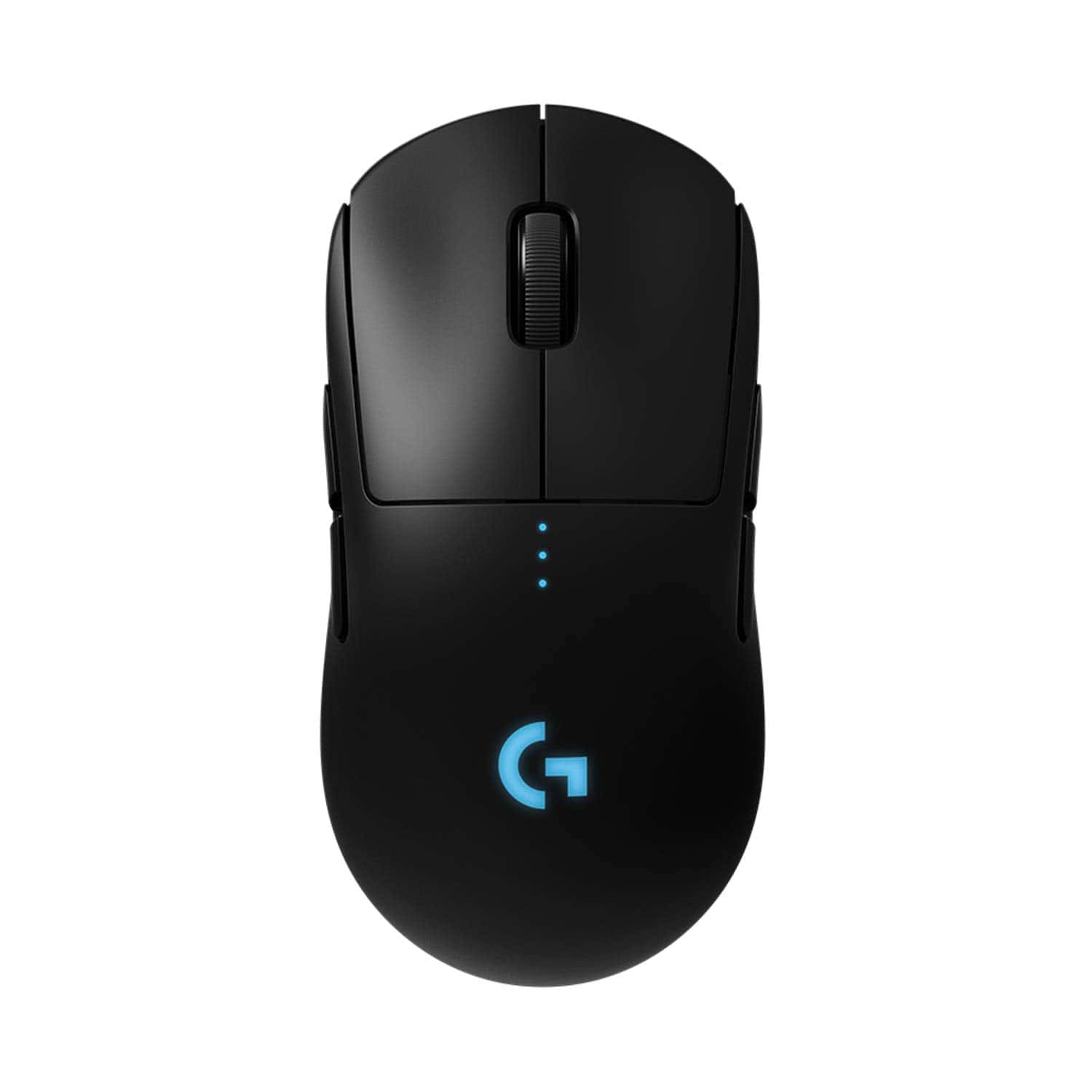
The Logitech G Pro Wireless offers the perfect blend of ultralight design and professional performance that makes it worth every penny for serious gamers.
Pros
- Incredibly responsive with virtually no lag
- Extremely lightweight at only 80 grams
- Ambidextrous design with customizable buttons
Cons
- Higher price point than wired competitors
- May feel too small for players with larger hands
- Battery needs recharging every 2-3 weeks with heavy use
We tested the Logitech G Pro Wireless extensively in fast-paced games, and its performance blew us away. The mouse glides effortlessly across the mousepad thanks to its lightweight design. At just 80 grams, it feels like an extension of your hand rather than a tool you’re controlling.
The HERO 25K sensor delivers pinpoint accuracy without any annoying acceleration or smoothing issues. We noticed the difference immediately in shooter games where precise aiming is crucial. The wireless connection is flawless – we couldn’t detect any input lag compared to wired mice we’ve used before.
Battery life impressed us, lasting about two weeks of heavy gaming before needing a recharge. The ambidextrous design works well for both right and left-handed players, with removable side buttons that can be configured based on your preference. Build quality feels premium despite the lightweight construction, with main buttons that have a satisfying click without being too loud. For serious gamers looking for a competitive edge without cable drag, this mouse is hard to beat.
Logitech G PRO X SUPERLIGHT Gaming Mouse
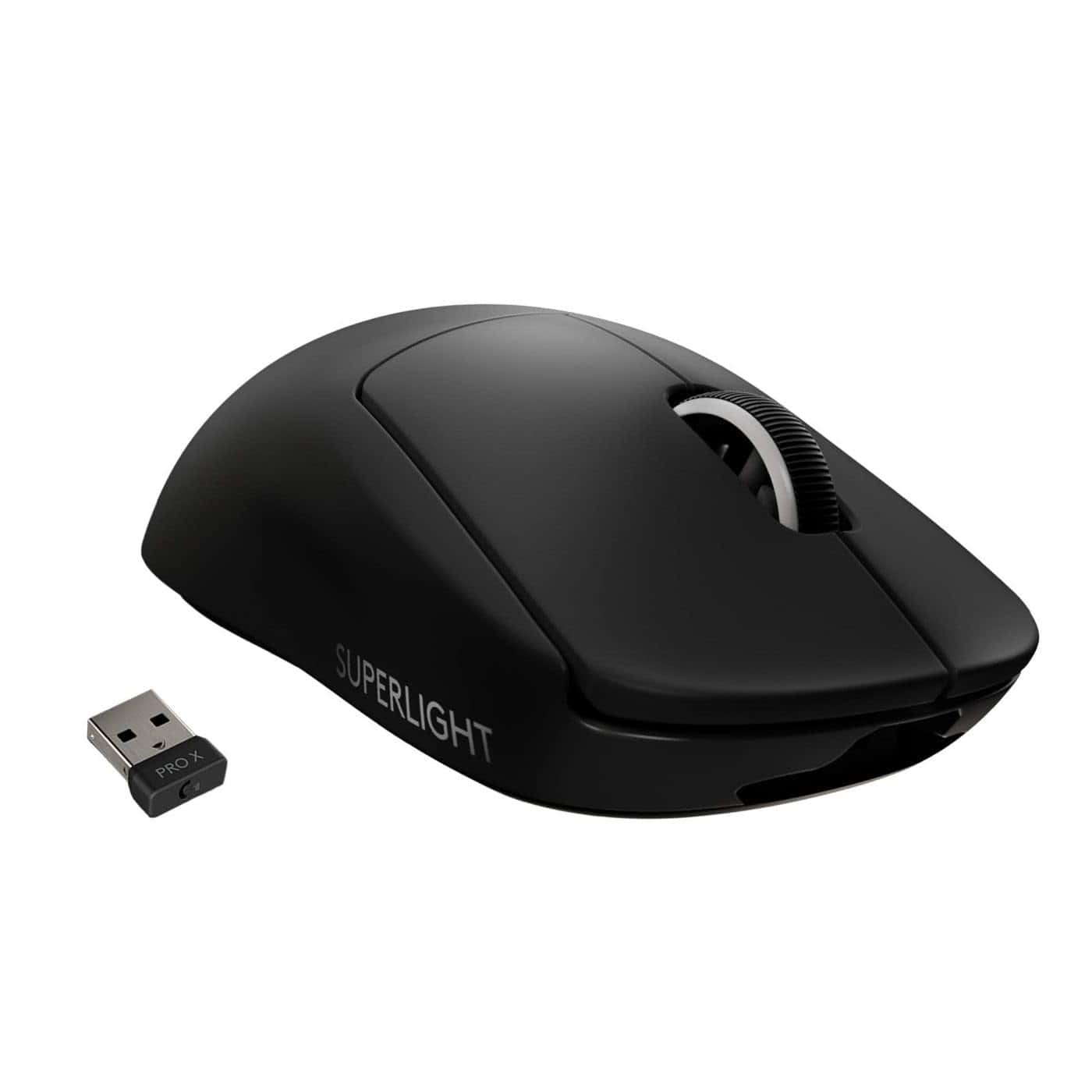
The Logitech G PRO X SUPERLIGHT offers an unbeatable combination of featherlight design and premium performance that makes it worth every penny for serious gamers.
Pros
- Incredibly light at under 63 grams
- Smooth gliding experience with zero-additive PTFE feet
- Impressive 70-hour battery life
Cons
- Higher price point than many gaming mice
- Only five programmable buttons
- Buttons require slightly firmer clicks
After testing the Logitech G PRO X SUPERLIGHT for several gaming sessions, we’re amazed by how its ultralight design transforms gameplay. At under 63 grams, it’s substantially lighter than most gaming mice we’ve used, yet it doesn’t feel cheap or hollow. The weight reduction makes quick flicks and precise movements much easier, especially during intense gaming sessions.
The HERO 25K sensor delivers exceptional tracking accuracy. We noticed zero lag or skipping even during the most rapid movements. The wireless connection is flawless – we couldn’t tell the difference between this and a wired mouse. This technology proves wireless mice can now match or exceed wired performance.
The PTFE feet on the bottom create an incredibly smooth glide across our mousepad. This frictionless movement combined with the lightweight design gives a feeling of direct connection to the game. Battery life is another standout feature – we’ve used it heavily for over a week without needing to recharge. While it has fewer buttons than some competitors, the five programmable ones are perfectly placed and responsive, though they do require a bit more pressure than we expected.
Logitech G Pro X Superlight 2
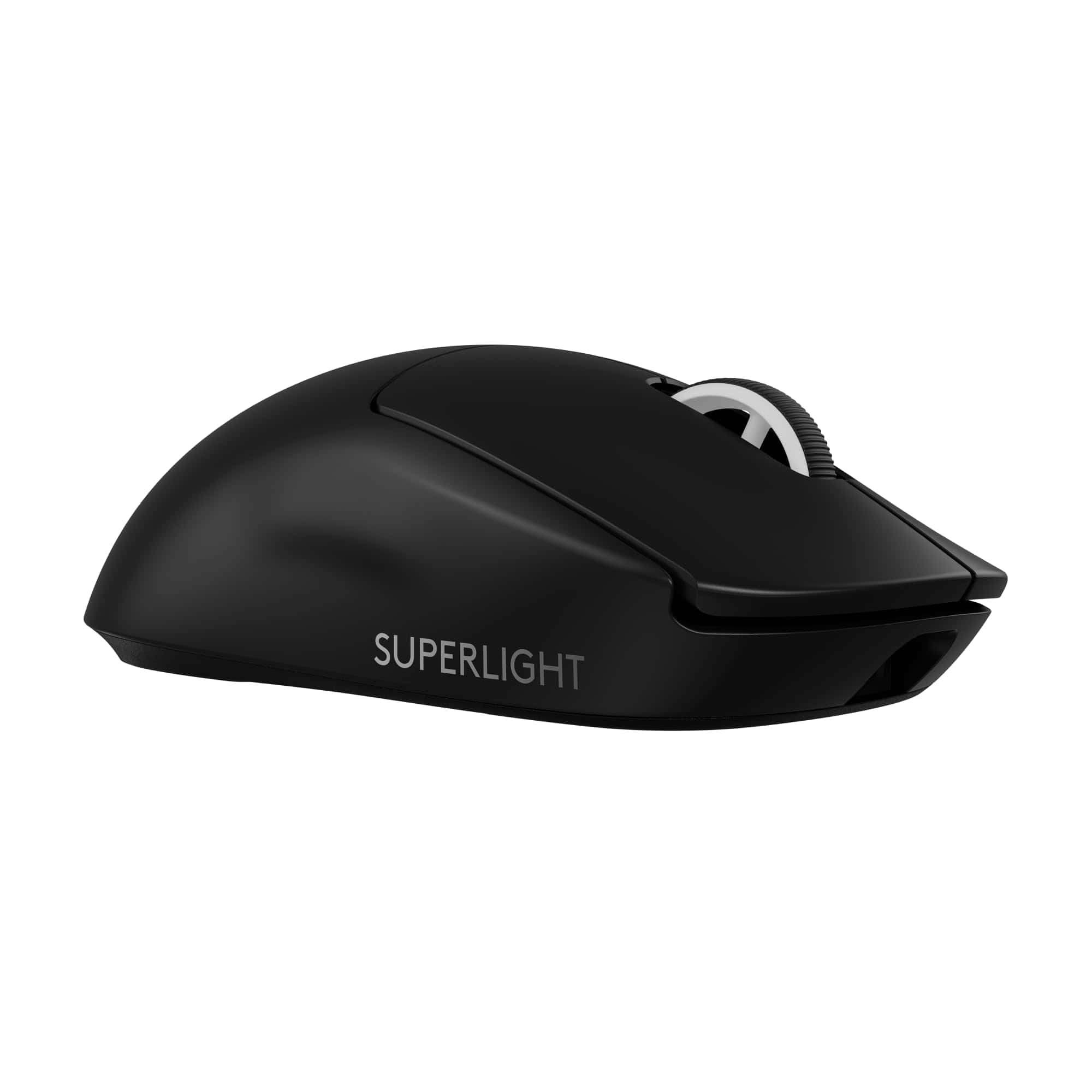
This ultra-lightweight wireless gaming mouse offers exceptional performance and precision that makes it worth the premium price for serious gamers and professionals alike.
Pros
- Incredibly light at just 60 grams
- Excellent 95-hour battery life
- Superior sensor accuracy with up to 44,000 DPI
Cons
- Premium price point
- Limited button configuration
- May feel too light for some users
We recently got our hands on the Logitech G Pro X Superlight 2, and it’s clear why pro gamers swear by this mouse. The first thing we noticed was its featherlight 60-gram weight. Picking it up feels almost like holding nothing at all, yet it maintains solid build quality that doesn’t feel cheap or flimsy.
The mouse glides across any surface with minimal effort thanks to its zero-additive PTFE feet. During intense gaming sessions, we found the new LIGHTFORCE hybrid switches offer a satisfying click while maintaining lightning-fast response times. The tactile feedback is perfect – not too stiff, not too mushy.
Battery life is impressive too. We used it heavily for over a week before needing to recharge via the included USB-C cable. The HERO 2 sensor tracked flawlessly on multiple surfaces with no jitter or spin-out issues. For FPS games especially, the precision was remarkable. The 8K polling rate provides ultra-smooth tracking that even the most demanding players will appreciate.
The simple, ergonomic shape fits comfortably in hand for hours of use. While some might prefer more buttons or customization options, we found the five programmable buttons sufficient for most gaming needs. The wireless connection never dropped during our testing, with no noticeable lag compared to wired alternatives.
SteelSeries Aerox 5 Mouse
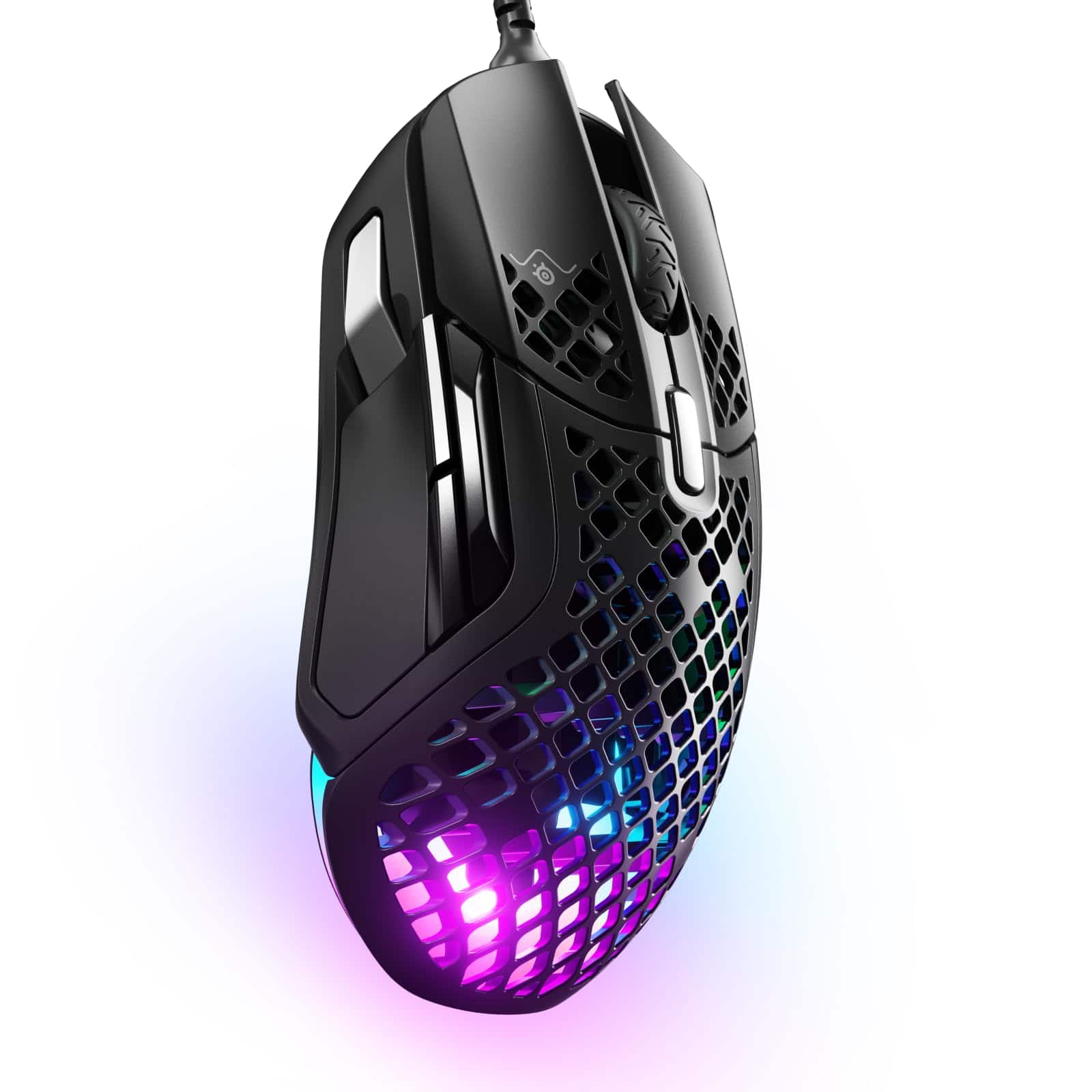
The Aerox 5 is our top pick for gamers seeking an ultra-lightweight mouse that doesn’t sacrifice features or durability.
Pros
- Incredibly light at just 66g with a honeycomb design
- Water and dust resistant (IP54 rating)
- Customizable 9-button layout with side panel
Cons
- Software requires account creation
- Middle scroll wheel issues reported by some users
- Honeycomb design may collect dust over time
We recently tested the SteelSeries Aerox 5, and the first thing we noticed was how effortless it felt to move. At just 66g, this mouse practically glides across mousepads. The honeycomb shell design isn’t just for show – it significantly reduces weight while maintaining structural integrity.
The build quality impressed us during our testing. Unlike some lightweight mice that feel flimsy, the Aerox 5 feels solid and well-built. The AquaBarrier technology provides IP54 protection against water splashes and dust, which gives us peace of mind during intense gaming sessions. We accidentally spilled some water near it during testing, and it continued working flawlessly.
Gaming performance stands out with the TrueMove Air optical sensor. We experienced no tracking issues or skipping during fast movements in FPS games. The nine programmable buttons, including the unique side panel and flick switch, give plenty of customization options for different game genres. The Golden Micro IP54 switches provide satisfying clicks with good tactile feedback, though they’re slightly louder than some competitors we’ve tested.
RGB lighting on the Aerox 5 looks stunning with three customizable zones. It’s not just flashy but also practical – we set up different color profiles to indicate DPI settings. Battery life is solid, though heavy RGB usage will drain it faster. For competitive gamers who value both lightweight design and extra buttons, this mouse hits the sweet spot between functionality and performance.
ASUS ROG Harpe Ace Extreme
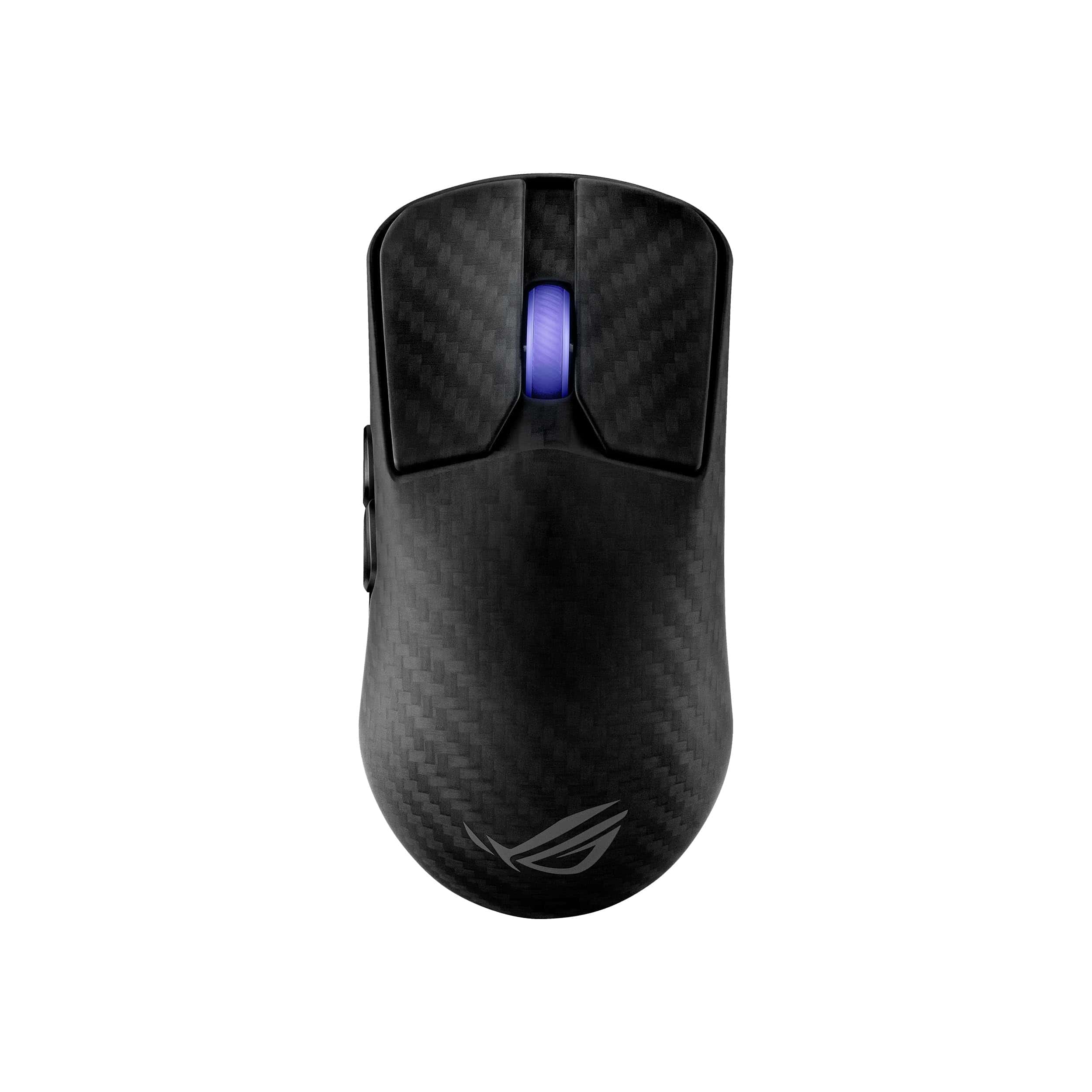
We believe the ASUS ROG Harpe Ace Extreme is worth the premium price for serious gamers who need an ultra-lightweight mouse with professional-grade performance.
Pros
- Incredibly light at just 47 grams
- Carbon fiber construction feels premium yet durable
- Exceptional 8000 Hz wireless polling rate
Cons
- Premium price point
- Slippery surface even with included grip tape
- Software can be finicky on some systems
The first thing we noticed when picking up the ROG Harpe Ace Extreme was its astonishing lightness. At only 47 grams, it feels like you’re moving air across your mousepad. This carbon fiber mouse makes quick flicks and precision aiming in FPS games noticeably easier than with heavier alternatives we’ve tested.
During our gaming sessions, the 42,000 DPI optical sensor performed flawlessly on multiple surfaces. We could adjust sensitivity on the fly, which proved particularly useful when switching between sniping and close-quarters combat. The optical micro switches offer a satisfying click without requiring too much pressure – perfect for marathon gaming sessions where finger fatigue becomes an issue.
Battery life impressed us at around 150 hours of real-world use. We appreciate the mouse’s shape, which was clearly designed with input from esports professionals. The size works best for fingertip and claw grip styles, though palm grip users with smaller hands might also find it comfortable. While the slippery surface remains our biggest complaint, the included grip tape helps somewhat, and the performance benefits far outweigh this minor inconvenience for competitive players seeking every possible advantage.
G-Wolves HSK Plus Lite Wireless Gaming Mouse

The G-Wolves HSK Plus Lite is a game-changer for fingertip grip users who want the lightest possible wireless mouse without sacrificing performance.
Pros
- Incredibly light at only 38g with a solid shell (no holes)
- Fast 2.4GHz wireless connection with under 1ms response time
- Perfect size and shape for fingertip grip users
Cons
- Too small for palm or claw grip styles
- Side buttons can be hard to reach for some users
- Battery indicator in software isn’t always accurate
We recently tested the G-Wolves HSK Plus Lite, and it’s hard to believe how light this mouse feels in hand. At just 38 grams, it’s among the lightest wireless gaming mice we’ve ever used, yet it doesn’t have the honeycomb design that many ultralight mice use. The solid shell feels surprisingly sturdy despite the minimal weight.
The compact size (89mm × 58mm × 38mm) makes this mouse perfect for fingertip grip users. When using it for fast-paced FPS games, we noticed how effortless it was to make quick flicks and micro-adjustments. The PAW3399 sensor tracked flawlessly even during our most aggressive swipes, and we experienced zero lag or connection issues with the 2.4GHz wireless.
The Zippy switches provide nice tactile feedback without requiring too much force – a good match for the mouse’s lightweight design. We found the software easy to use for adjusting DPI, polling rate, and setting up macros. The side buttons are well-placed for fingertip users, though they might be harder to reach if you have larger hands. Battery life was solid, lasting through several intense gaming sessions before needing a charge.
G-Wolves Skoll Mini Gaming Mouse
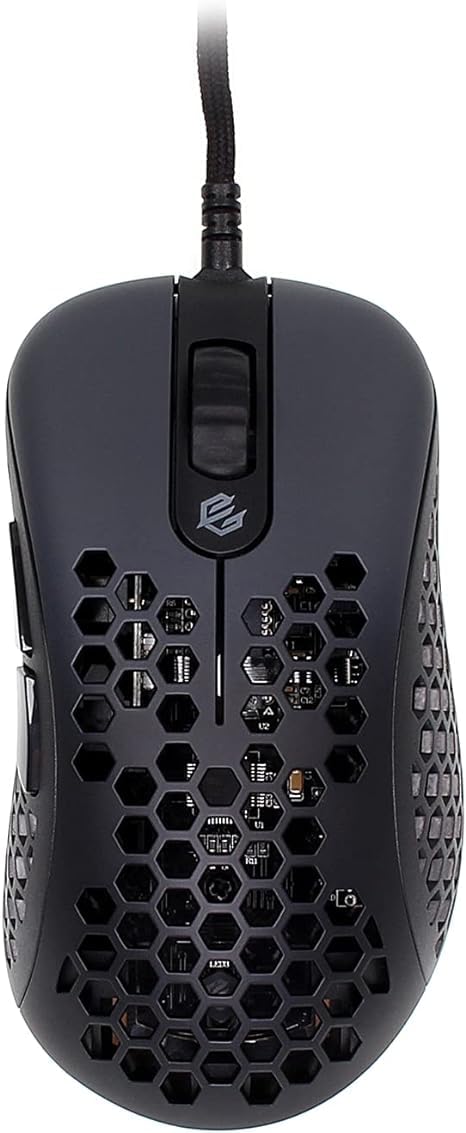
The G-Wolves Skoll Mini offers an incredibly lightweight gaming experience at just 50g, making it perfect for gamers who prioritize quick movements and reduced hand fatigue.
Pros
- Ultralight 50g honeycomb design reduces hand strain
- Detachable paracord cable minimizes drag during gameplay
- Comes with extra PTFE skates and grip tape
Cons
- May be too small for gamers with larger hands
- Some users report slightly mushy buttons
- Software feels outdated
We spent several hours testing the G-Wolves Skoll Mini, and the first thing we noticed was how incredibly light it felt in our hands. At just 50g, it’s one of the lightest ergonomic mice we’ve used. The honeycomb design not only contributes to the weight reduction but also allows for better airflow to keep your palm cool during intense gaming sessions.
The Pixart 3389 sensor performed flawlessly in our tests. With 16,000 DPI and excellent tracking accuracy, we didn’t experience any skipping or lag issues even during fast-paced FPS games. The detachable paracord cable is a standout feature – it feels almost wireless due to its flexibility and light weight, which greatly reduced drag compared to standard cables.
The box includes some nice extras that add value. We particularly liked the extra PTFE skates that came in the package, as well as the textured grip tape for those who want additional control. The compact size fits perfectly for claw grip users or those with small to medium hands. While it might be too small for larger hands, the ergonomic shape provides excellent comfort for extended gaming sessions. For its price point, this mouse delivers exceptional performance that rivals much more expensive options.
Keychron M3 Mini Mouse
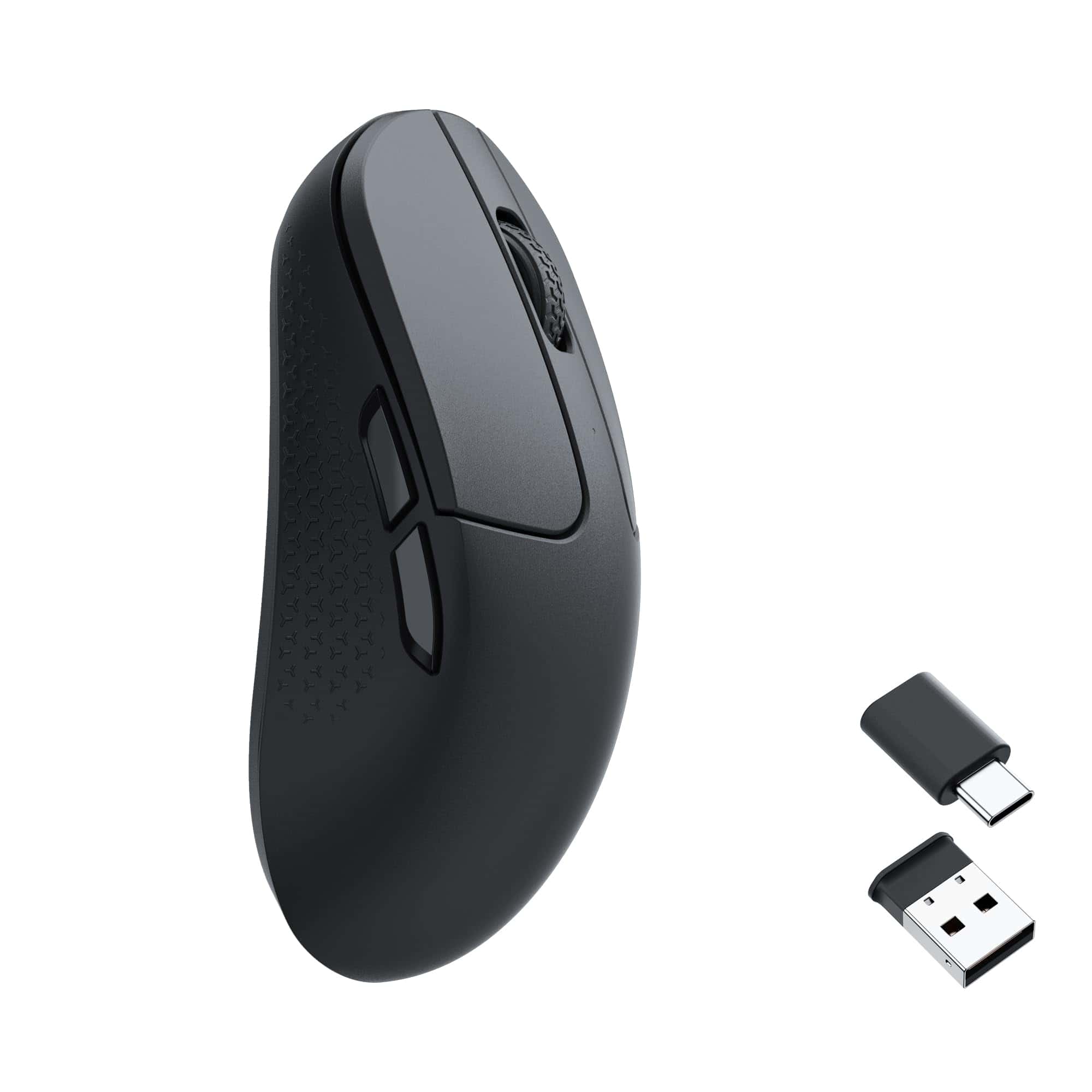
The Keychron M3 Mini offers incredible performance in an ultra-lightweight package that makes it perfect for both gaming and productivity.
Pros
- Extremely lightweight at only 55g
- Multiple connection options (Bluetooth, 2.4GHz, wired)
- High-end PixArt 3395 sensor with up to 26,000 DPI
Cons
- Plastic build might feel too light for some users
- Battery life could be better
- Software has a learning curve
We recently tested the Keychron M3 Mini and were impressed by how light it feels in hand. At just 55 grams, it’s one of the lightest gaming mice we’ve used. The weight makes a noticeable difference during long gaming sessions, reducing wrist fatigue significantly.
Connectivity is a strong point with this mouse. We switched between the 2.4GHz wireless dongle for gaming and Bluetooth for everyday work tasks. The transitions were smooth, and we didn’t notice any lag when using the wireless dongle. The option to use it wired via USB-C is great for when you’re charging.
The sensor performance exceeded our expectations. The PixArt 3395 sensor tracks beautifully on various surfaces. We tested it on cloth and hard mouse pads, and the precision remained consistent. For FPS games, the high polling rate and DPI settings gave us an edge in competitive matches.
Build quality is solid despite the lightweight construction. The clicks from the Huano switches feel crisp and responsive. We especially like the ergonomic shape that fits comfortably in medium to small hands. The mouse feet glide smoothly across surfaces, adding to the premium feel of the device.
Redragon M916AK PRO Anime Gaming Mouse
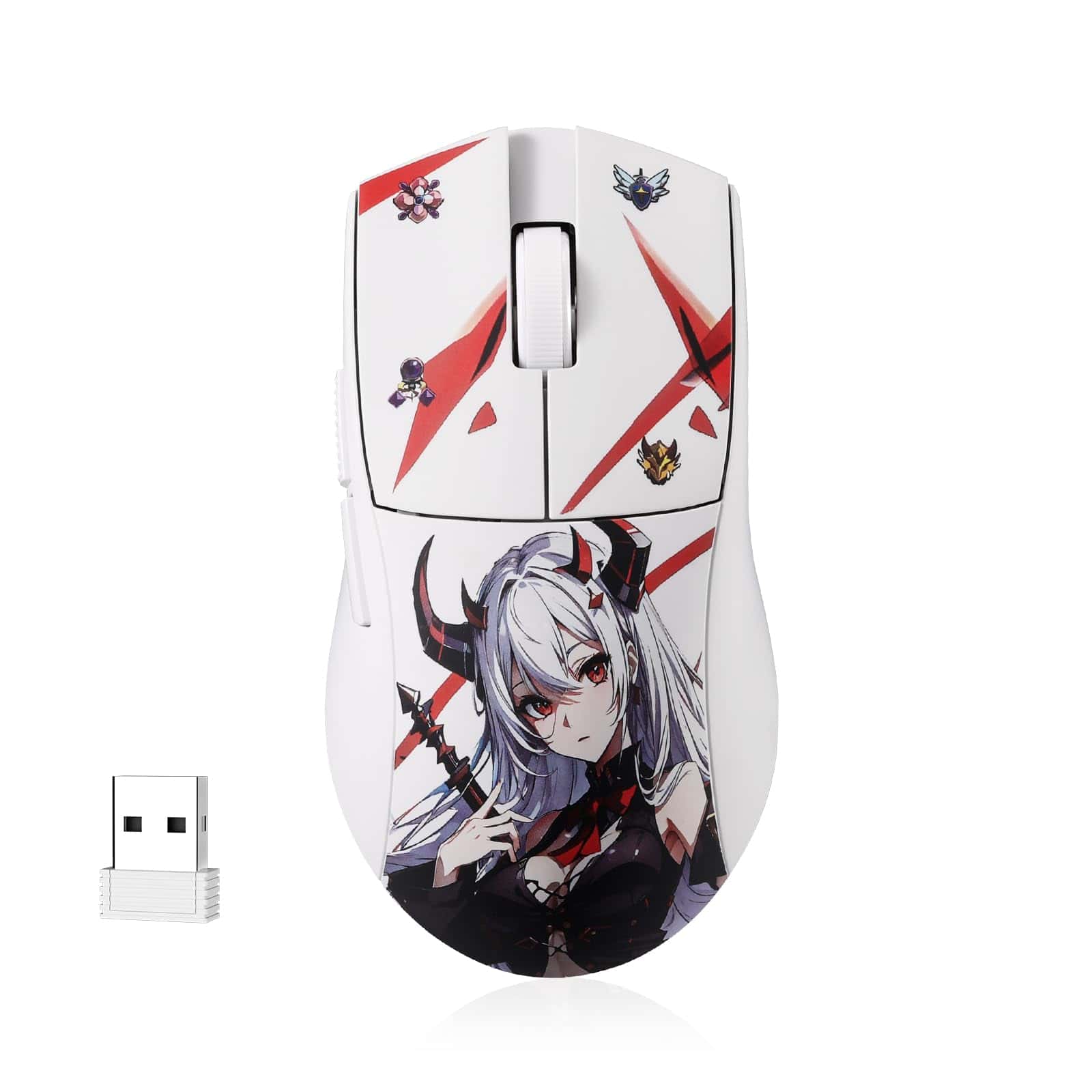
The Redragon M916AK PRO is a surprisingly capable ultra-lightweight gaming mouse that delivers professional performance without emptying your wallet.
Pros
- Incredibly light at just 42 grams
- Three connection options (Bluetooth, 2.4GHz wireless, USB-C)
- Customizable DPI up to 26,000
Cons
- Anime design might not appeal to everyone
- May feel too light for users accustomed to heavier mice
- Performance varies on different mouse pad surfaces
We recently tested the Redragon M916AK PRO, and its featherweight design immediately stood out. At just 42 grams, it’s one of the lightest gaming mice we’ve handled. Moving it across the desk feels effortless, almost like the mouse is floating.
The triple connectivity options proved extremely useful in our testing. We could quickly switch between our gaming PC using the 2.4GHz wireless connection for minimal latency, then pair it with our laptop via Bluetooth for work. The USB-C option serves as both a charging method and wired connection when needed.
What impressed us most was the precision. The sensor performed admirably in fast-paced games, and the five programmable buttons responded instantly to our clicks. The ergonomic shape fits comfortably in hand, making long gaming sessions less tiring than expected. For its price point, this mouse delivers performance that rivals much more expensive competitors.
Darmoshark M2 Gaming Mouse
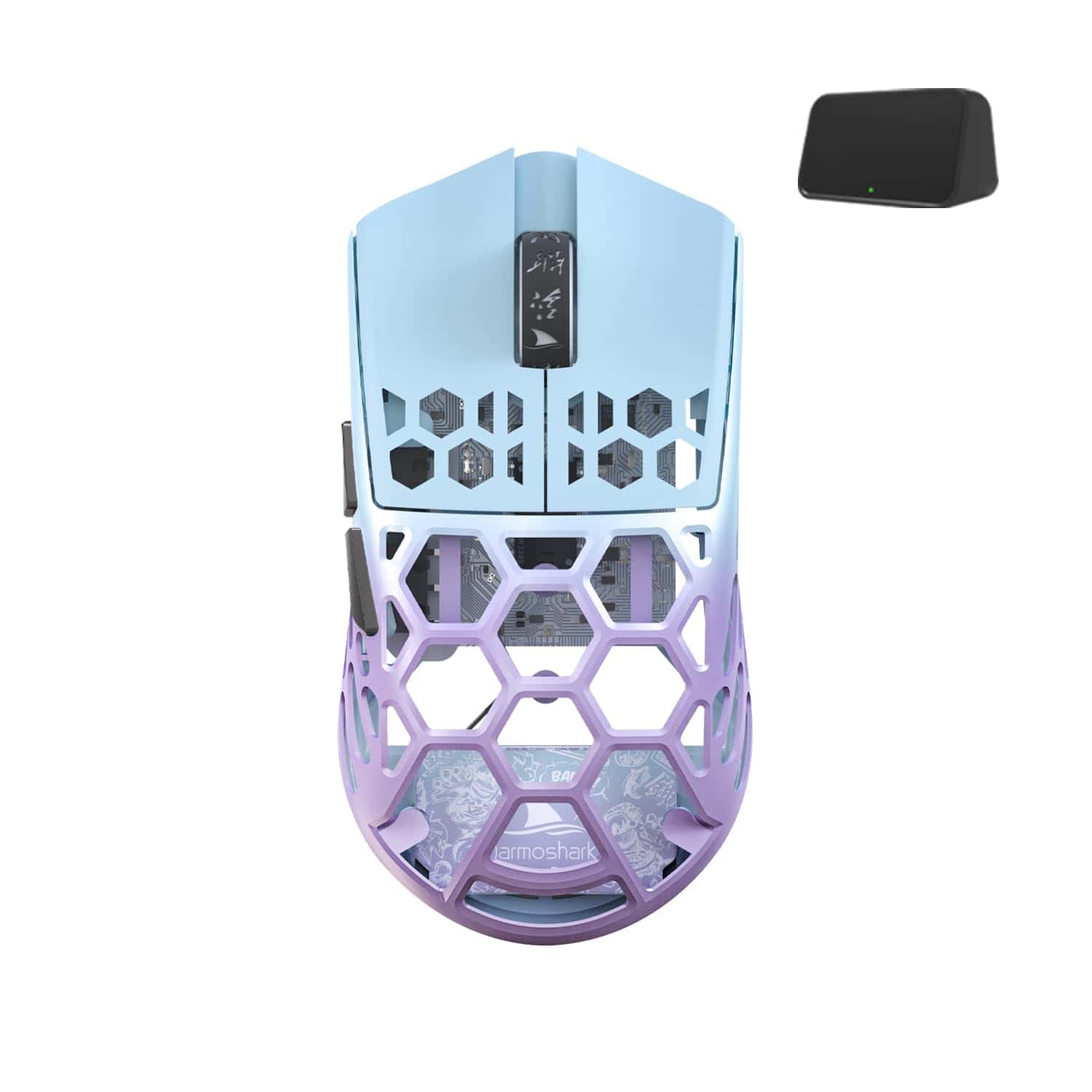
The Darmoshark M2 delivers impressive performance in an ultra-lightweight package that won’t strain your wrist during long gaming sessions.
Pros
- Incredibly light at just 39g with magnesium alloy construction
- Three connection modes (4K wireless, Bluetooth, USB-C)
- Top-tier PAW3395 sensor with up to 26000 DPI
Cons
- Larger size may not suit small hands
- Limited programmable buttons for MMO games
- Purple color might not appeal to everyone
We recently tested the Darmoshark M2 and were amazed by how light it feels in hand. At only 39 grams, it’s among the lightest gaming mice we’ve used. The magnesium alloy construction gives it strength without adding weight, making it perfect for long gaming sessions where wrist fatigue is a concern.
The mouse performed exceptionally well during fast-paced games. Its PAW3395 sensor tracked perfectly on various surfaces with no input lag. Switching between the three connection modes (4K wireless, Bluetooth, and wired USB-C) was simple, and we noticed no performance drop when using it wirelessly. Battery life impressed us too – we got several days of heavy use before needing to recharge.
Comfort-wise, the M2 fits medium to large hands best. Its right-handed ergonomic design supported our palm nicely, though folks with smaller hands might find it a bit bulky. The clicks felt crisp and responsive, not mushy like some lightweight mice. The five programmable buttons were easy to customize through the software, though hardcore MMO players might want more options. For most gamers looking for a super lightweight mouse with premium performance, the Darmoshark M2 offers excellent value.
Razer DeathAdder V3
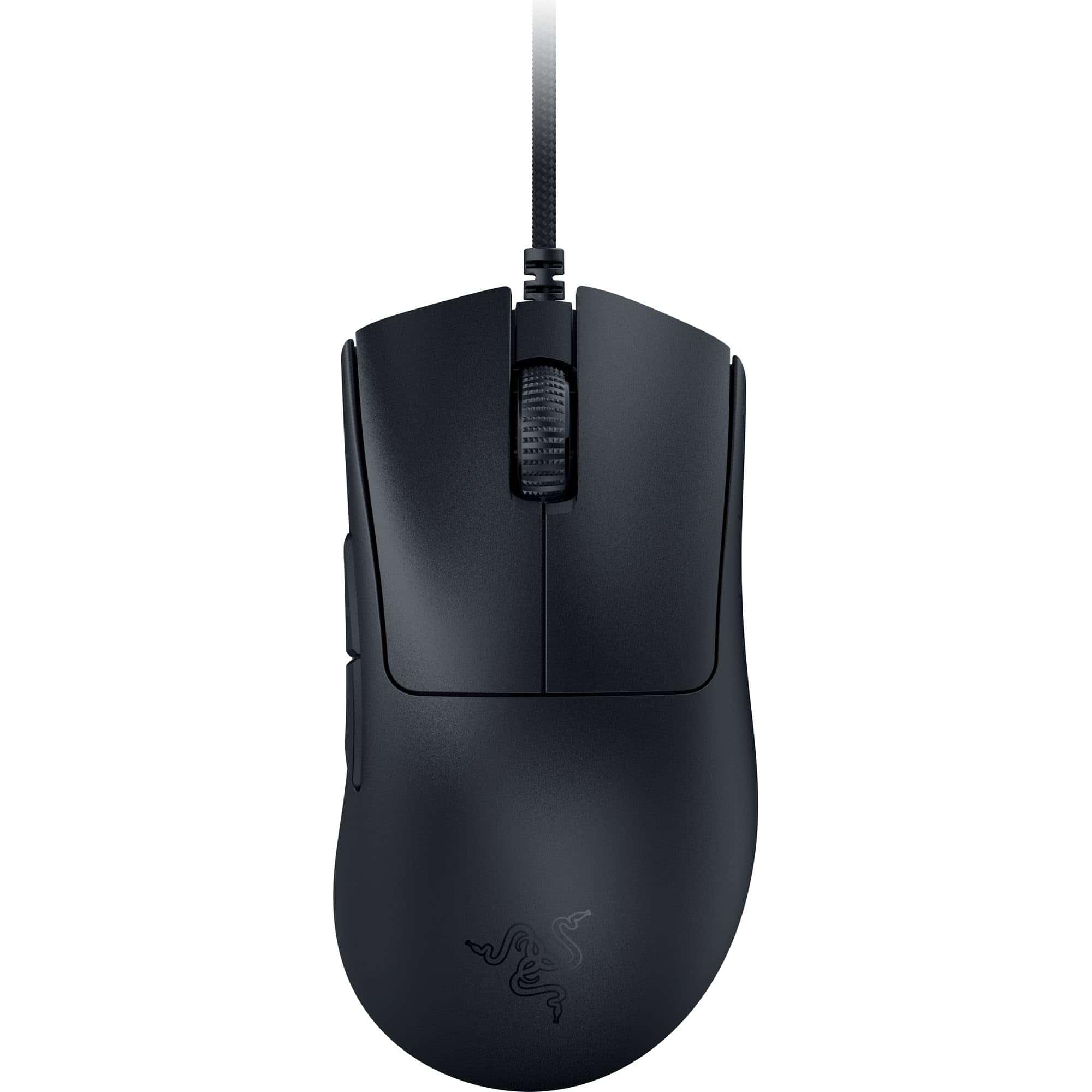
The DeathAdder V3 stands out as the best ultra-lightweight ergonomic gaming mouse with its incredible 59g design and top-tier performance features.
Pros
- Incredibly light at 59g while maintaining comfort
- Precise tracking with the Focus Pro 30K sensor
- Fast, reliable optical switches with no double-clicking issues
Cons
- Scroll wheel may develop issues over time
- Cord can sometimes get in the way during fast movements
- Price is higher than some competitors
We tested the Razer DeathAdder V3 for several weeks of intense gaming sessions. The first thing we noticed was how light it felt in our hands. At just 59g, it’s hard to believe this mouse packs so much tech inside. The weight reduction makes a real difference during long play sessions, reducing hand fatigue significantly.
The ergonomic shape fits our hands perfectly. Razer worked with pro gamers to refine the iconic DeathAdder design, and it shows. The contours support a natural palm grip while still working well for claw grip players. We found the side buttons placed perfectly within thumb reach, making them easy to press without accidents.
Moving to performance, the optical sensor is nothing short of amazing. The Focus Pro 30K sensor tracked flawlessly on every surface we tried, even glass. Paired with the 8K Hz polling rate, the mouse feels incredibly responsive. The optical switches deserve special mention too – they click with a satisfying feel and zero delay. After days of testing, we didn’t experience any double-clicking issues that plague mechanical switches.
Razer Cobra Mouse
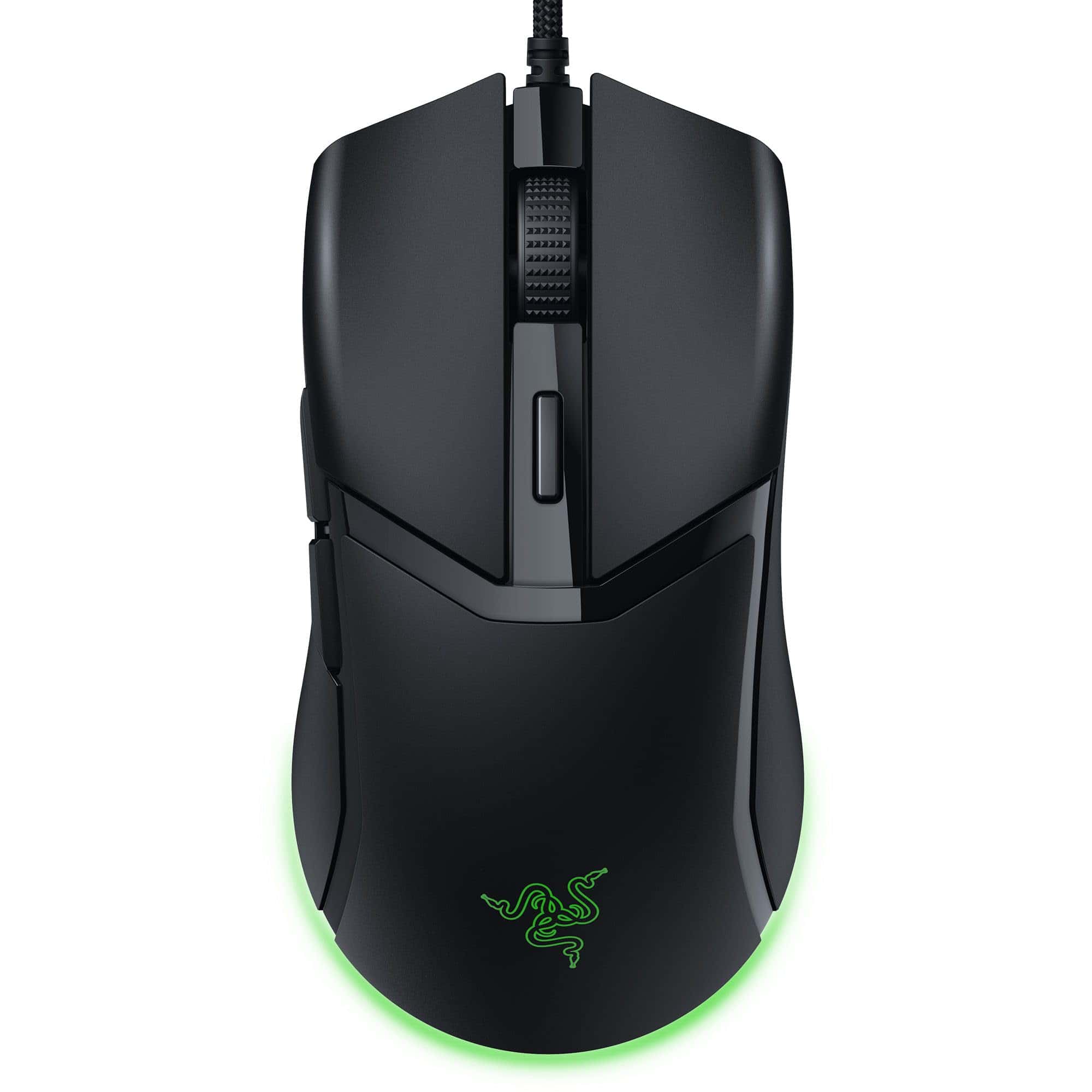
The Razer Cobra is a remarkably lightweight gaming mouse that delivers precision and comfort without compromising on features or durability.
Pros
- Ultra-lightweight at just 58g for quick movements
- Durable optical switches rated for 90 million clicks
- Smooth-gliding PTFE feet for better control
Cons
- Wired design may limit desk setup options
- Might feel too small for users with larger hands
- RGB lighting drains more PC resources
We recently tested the Razer Cobra and were immediately impressed by how light it feels in hand. At just 58 grams, this mouse practically floats across the mousepad. The lightweight design doesn’t mean it’s flimsy, though – the build quality is solid with no rattling or cheap plastic feel.
The mouse glides incredibly smoothly thanks to the 100% PTFE feet. During intense gaming sessions, we noticed the difference immediately compared to heavier mice. Our aim in FPS games was noticeably more precise, and we experienced less hand fatigue during marathon gaming sessions.
Clicking feels amazing with Razer’s Gen-3 optical switches. They’re crisp, responsive, and satisfying to use. The 8500 DPI optical sensor lets us fine-tune our sensitivity in 50 DPI increments, which was perfect for switching between different games. The Speedflex cable is another standout feature – it’s so flexible that it almost feels wireless.
The Chroma RGB lighting looks stunning with its gradient underglow effect. We appreciated how it syncs with other Razer peripherals and reacts to in-game events in compatible titles. The size works well for claw and fingertip grip styles, though palm grip users might find it a bit small.
For its price point, the Razer Cobra offers excellent value with high-end features typically found in more expensive mice. We found it to be a reliable, comfortable option that doesn’t weigh down our gameplay.
SteelSeries Aerox 9 Wireless Mouse
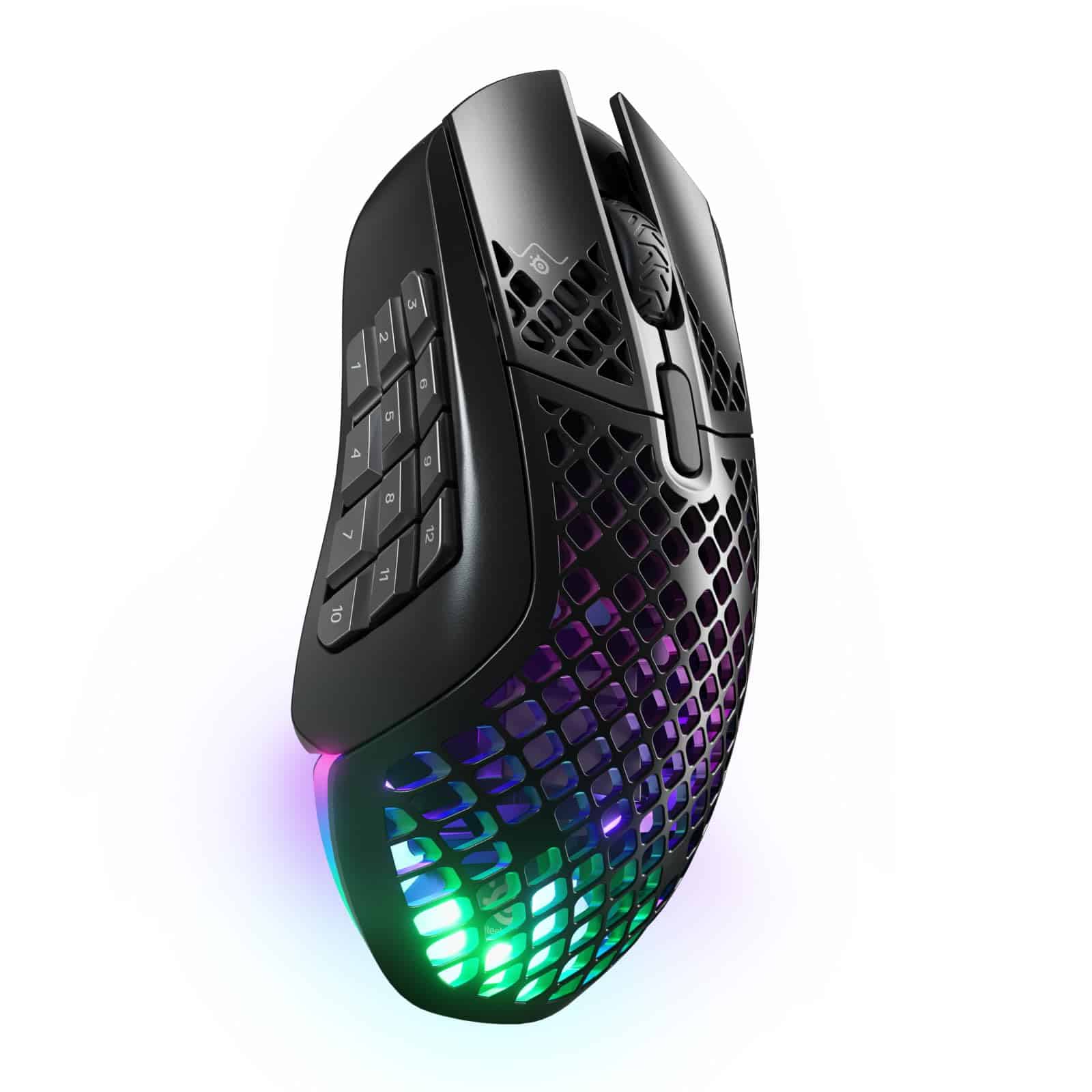
The Aerox 9 offers an impressive lightweight design with tons of buttons, but its high price and some quality concerns make it best for serious MMO gamers only.
Pros
- Incredibly light at just 89g despite having 18 programmable buttons
- Long 180-hour battery life with dual wireless connectivity options
- Water and dust resistant with IP54 rating
Cons
- Side button layout can be awkward to reach all buttons
- Some quality issues reported by users
- Expensive compared to similar gaming mice
We recently tested the SteelSeries Aerox 9 Wireless and were impressed by how light it feels in hand. At only 89 grams, it’s surprisingly nimble for a mouse packed with 18 programmable buttons. The honeycomb design not only cuts weight but also shows off the RGB lighting nicely.
The 12-button side panel is the main attraction here. During our gaming sessions, we found having all those buttons at our fingertips was great for MMOs like World of Warcraft and MOBAs. However, the button layout takes time to master. Some buttons were harder to reach than others, and we accidentally clicked the wrong ones at first.
Battery life is a strong point. We got nearly two weeks of heavy use before needing to recharge. The dual wireless options (2.4GHz for gaming and Bluetooth for general use) worked well, with no noticeable lag on the 2.4GHz connection. The water and dust resistance gives peace of mind if you’re prone to spills. While we like the lightweight design, some users might find it feels less solid than heavier mice.
HK Gaming Mira M Lightweight Mouse
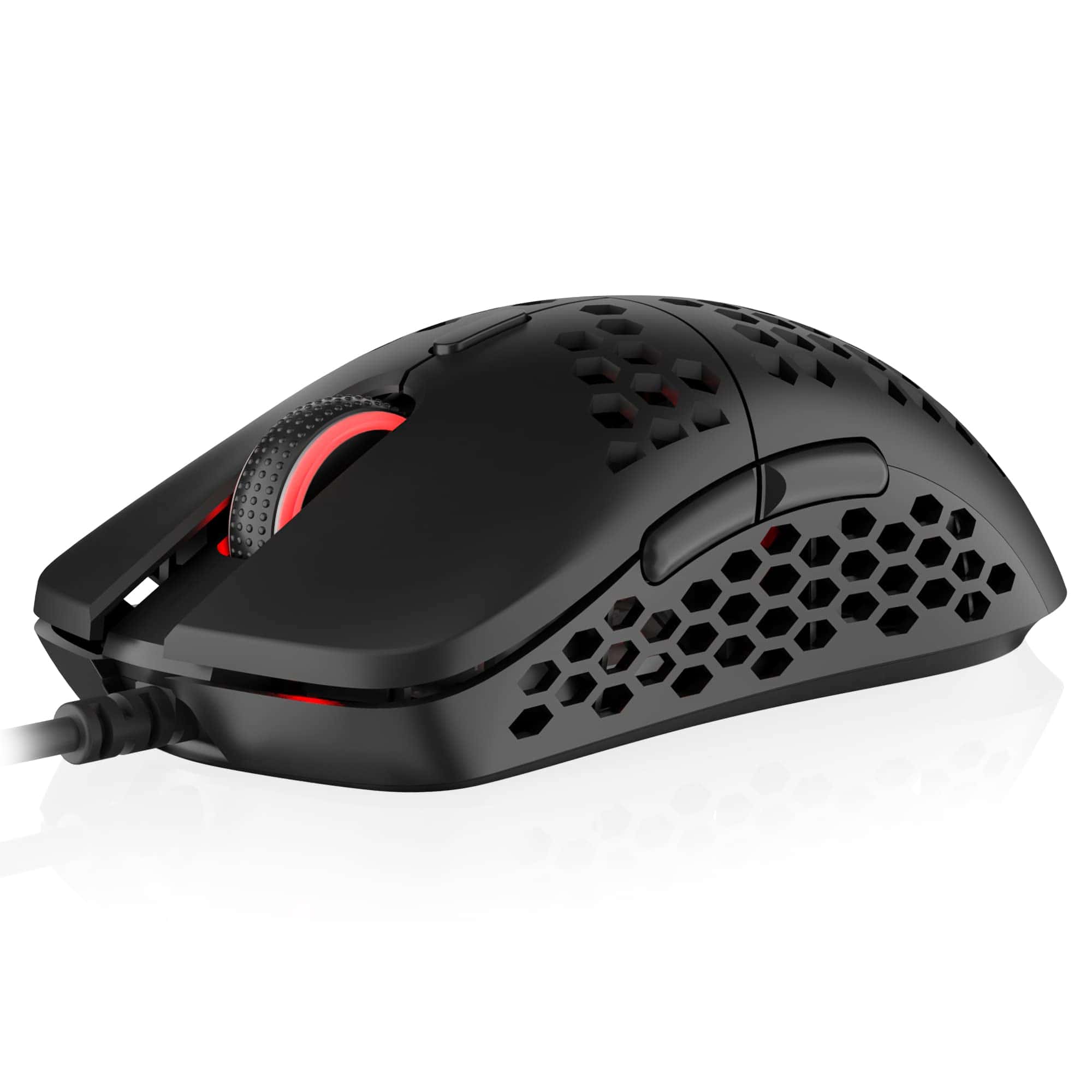
The Mira M’s ultra-light 63g design and responsive sensor make it perfect for gamers who need speed without sacrificing comfort or precision.
Pros
- Incredibly lightweight at just 63g for reduced hand fatigue
- Smooth gliding with premium PTFE feet
- Durable switches rated for 50 million clicks
Cons
- Honeycomb design might collect dust over time
- Cable, while flexible, isn’t wireless
- May feel too light for some users
We recently tested the HK Gaming Mira M and were immediately struck by how light it feels in hand. At just 63 grams, it’s among the lightest gaming mice we’ve used, making quick flicks and extended gaming sessions much less tiring. The honeycomb shell design isn’t just for looks – it truly cuts weight while maintaining structural integrity.
Movement with this mouse feels effortless. The PTFE feet provide a consistent glide across all our mousepads, and the Pixart PMW3360 sensor tracks perfectly at high speeds. We noticed zero spin-outs or tracking issues even during the most intense gaming moments. The adjustable CPI (up to 12000) gave us plenty of options to find our perfect sensitivity.
The build quality impressed us despite the lightweight design. The Omron switches have a satisfying click without being too loud, and the flexible paracord-style cable reduces drag significantly compared to standard rubber cables. The side buttons are well-placed and responsive, while the RGB lighting on the scroll wheel adds a touch of customization without being overwhelming. For anyone looking to reduce arm fatigue without sacrificing performance, the Mira M delivers exceptional value.
ASUS ROG Keris II Ace
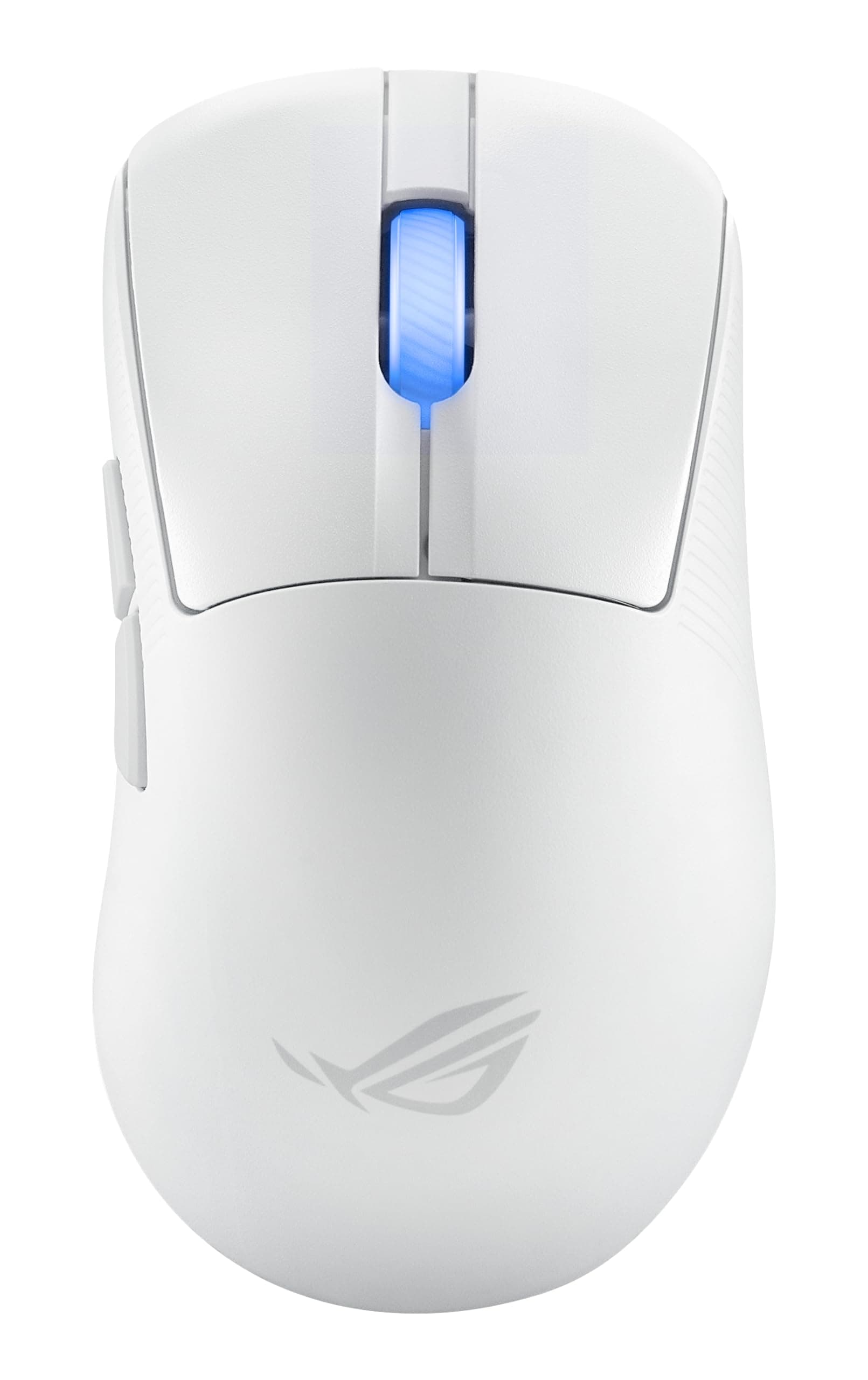
We recommend this ultralight gaming mouse for its comfortable ergonomic shape, impressive sensor accuracy, and versatile connectivity options that make it perfect for competitive FPS players.
Pros
- Incredibly lightweight at just 54g for effortless movement
- Ergonomic design prevents hand strain during long gaming sessions
- Multiple connectivity options with impressive 4K Hz wireless polling rate
Cons
- Might feel small for gamers with larger hands
- Premium price point compared to other gaming mice
- Learning curve when switching from ambidextrous mice
After spending time with the ROG Keris II Ace, we were immediately struck by its featherlight feel. At just 54g, it glides across mousepads with minimal effort. The ergonomic right-handed shape nestles perfectly in the palm, providing excellent support during intense gaming marathons.
The sensor performance blew us away. The AimPoint Pro 42K optical sensor tracks flawlessly on practically any surface – even glass! When playing tactical shooters, we noticed pixel-perfect precision that genuinely improved our aim. The optical switches deliver crisp, responsive clicks with none of the double-clicking issues that plague mechanical alternatives.
Connectivity options are where this mouse truly shines. We tested all three modes: 2.4GHz wireless with the ROG Polling Rate Booster (pushing it to an impressive 4000Hz polling rate), standard USB, and Bluetooth. The wireless performance was indistinguishable from wired, even in our crowded office with lots of wireless interference. Battery life impressed us too, lasting over 100 hours on a single charge during real-world use.
Glorious Model O Wireless
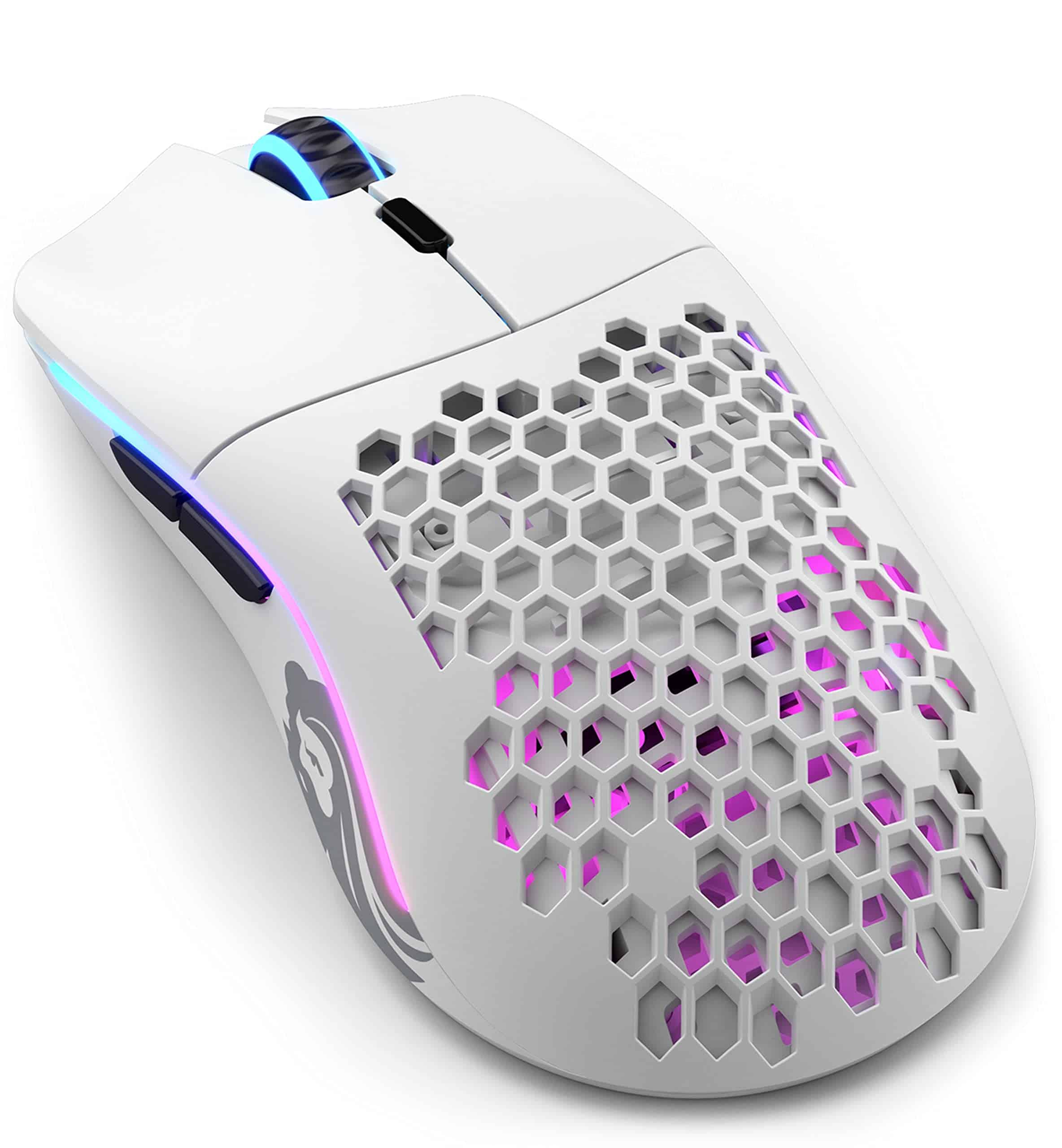
The Glorious Model O Wireless is an excellent choice for gamers seeking a lightweight mouse with reliable wireless performance at a more affordable price than premium competitors.
Pros
- Extremely lightweight at only 69g with honeycomb design
- Strong battery life up to 71 hours with RGB off
- Responsive 2.4GHz wireless connection with minimal lag
Cons
- Software could use improvements
- Honeycomb holes might not appeal to everyone
- Side buttons could be more tactile
We’ve been testing the Glorious Model O Wireless for several weeks now, and it’s impressed us with its featherlight feel. At just 69 grams, this mouse glides effortlessly across our mousepad, making quick flicks in FPS games feel almost effortless. The honeycomb shell design contributes to this lightness without making the mouse feel flimsy.
Wireless performance is where this mouse really shines. We noticed virtually no difference between this and a wired mouse during our gaming sessions. The 2.4GHz connection stayed stable even in environments with other wireless devices nearby. When gaming competitively, the 19,000 DPI sensor and 1,000Hz polling rate provided precise tracking with no noticeable input lag.
Battery life has been impressive in our testing. With RGB lighting turned off, we easily got through a full week of heavy use before needing to recharge. Even with the lights on, the battery lasted several days. The included USB-C cable lets you keep playing while charging, and it’s remarkably flexible compared to other charging cables we’ve used.
The RGB lighting looks vibrant and can be customized through Glorious CORE software. While the software gets the job done, it’s not as polished as competitors like Logitech or Razer. For the price point, though, we found the Model O Wireless offers excellent value, especially for competitive gamers who prioritize weight and performance over extra features.
Buying Guide
Finding the right lightweight mouse can make a big difference in your gaming or work setup. We’ll show you what to look for when shopping for the best lightweight mouse.
Weight Considerations
The weight of your mouse matters a lot. Most lightweight mice weigh between 50-80 grams. For competitive gaming, mice under 70 grams are often preferred.
Anything under 60 grams is considered ultralight. These super light options can help reduce hand fatigue during long gaming sessions.
Shape and Size
Your hand size and grip style should guide your choice. Mice come in different shapes that work better for specific grips.
| Grip Style | Best Shape Type |
|---|---|
| Palm Grip | Larger, ergonomic mice |
| Claw Grip | Medium-sized, humped designs |
| Fingertip Grip | Small, low-profile mice |
Measure your hand from wrist to fingertip. This measurement helps match you with the right size mouse.
Sensor Performance
A good sensor ensures accurate tracking. Look for mice with high-quality optical sensors that offer:
- No acceleration or smoothing
- High IPS (inches per second) tracking
- Low lift-off distance
- Adjustable DPI settings
Cable Type
Cables can affect how your mouse feels and moves. Lightweight, flexible “paracord” cables reduce drag and feel closer to wireless.
Wireless options eliminate cable drag completely but may add weight from batteries.
Build Quality
Lightweight doesn’t have to mean flimsy. Look for mice with:
- Solid construction without flexing
- Quality switches rated for millions of clicks
- Durable scroll wheels
- Good feet that glide smoothly
Frequently Asked Questions
We’ve gathered the most common questions about lightweight mice for gaming. These questions cover important features, top brands, performance benefits, and design considerations.
What features are important in a lightweight gaming mouse?
When picking a lightweight gaming mouse, look for high-quality sensors that track accurately. A mouse with 16,000 DPI or higher gives you great precision.
Durable switches that can handle millions of clicks are essential. Many top mice use Omron switches rated for 20-50 million clicks.
Good grip textures help you control the mouse during fast movements. A flexible, lightweight cable (or no cable at all) reduces drag during gameplay.
Which brands offer the best lightweight mice for gamers?
Glorious PC Gaming Race offers excellent lightweight options like the Model O, weighing just 67 grams. Their honeycomb design cuts weight without sacrificing durability.
Logitech’s G Pro X Superlight weighs only 63 grams and delivers professional-grade performance. Razer’s Viper series includes ultra-light mice with weights under 70 grams.
Finalmouse creates limited-edition ultralight mice that sell out quickly. Smaller companies like Pulsar and Xtrfy also make excellent lightweight options.
How does mouse weight affect gaming performance?
Lighter mice let you make faster movements with less effort. This is especially helpful in fast-paced games like first-person shooters.
Less weight reduces hand fatigue during long gaming sessions. Many pro players prefer mice under 80 grams for better control and quicker reactions.
A lightweight mouse can improve your aim because it’s easier to stop precisely where you want. This gives you an edge in competitive gaming.
What are the benefits of using a wireless gaming mouse over a wired one?
Modern wireless mice have virtually no lag, matching wired performance. Companies like Logitech and Razer have perfected their wireless technology.
No cable means no drag or snags during intense gameplay. This freedom of movement can improve your gaming experience.
Battery life has improved dramatically, with many models lasting 60+ hours on a charge. Some wireless mice are now lighter than their wired counterparts, offering the best of both worlds.
Are there any ultra-lightweight mice designed specifically for professional esports?
Yes, many brands make pro-level ultralight mice under 60 grams. The Finalmouse Starlight-12 weighs just 42 grams thanks to its magnesium alloy shell.
Glorious Model O- (minus) was designed with input from esports players. Endgame Gear’s XM1r is popular among FPS professionals for its ultralight design and fast click response.
These mice often include customizable polling rates and optional software for fine-tuning performance. Many pro mice also have shapes tested and approved by competitive players.
How do ergonomic considerations factor into the design of lightweight mice?
The best lightweight mice balance low weight with comfortable shapes. Hand size compatibility is crucial—mice come in various sizes to fit different hands.
Button placement should feel natural and prevent accidental clicks. Some mice offer modular parts so you can adjust the shape to fit your grip style.
Well-designed lightweight mice prevent hand strain despite removing material. Quality lightweight mice maintain good weight distribution even with their reduced mass.

